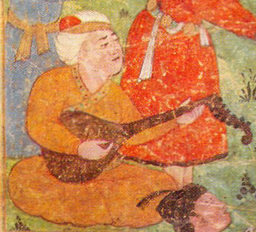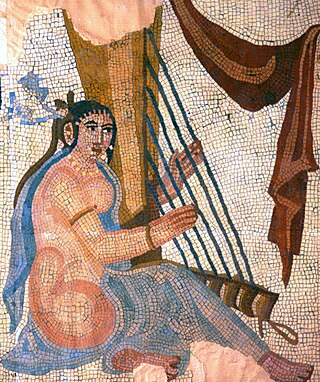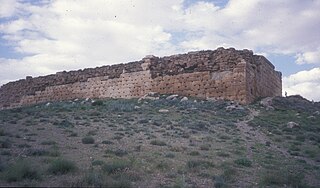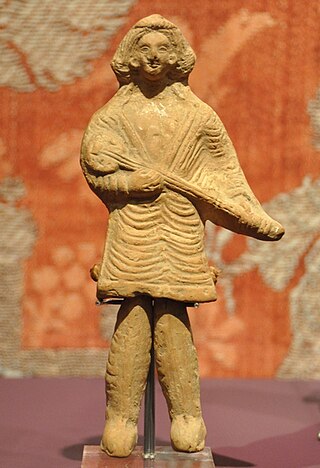
The Achaemenid Empire, a major state of ancient Iran, lasted from 550 BCE to 330 BCE, in which music played a prominent role.

The Achaemenid Empire, a major state of ancient Iran, lasted from 550 BCE to 330 BCE, in which music played a prominent role.
The Achaemenid Empire was a major state of ancient Iran from 550 BCE to 330 BCE. It arose from the conquests of Cyrus the Great, whose familial dynasty, was named for their mythical progenitor-ancestor Achaemenes. [1] At its height, it was the largest empire by that point in history, spanning from the Balkans to Northern Ancient Egypt and the Indus Valley. [1] A further source of unification arose from the widespread adoption of Zoroastrianism as set forth by the prophet Zoroaster a few centuries earlier. [2] The empire fell to the conquests of Alexander the Great, under whose successors formed the Seleucid Empire. [1]
The earliest music in Persia is difficult to pinpoint, due to a paucity of extant records. [3] Persian music has existed in Persia since at least c. 3300–3100 BCE of the Elam period, from when the earliest artistic depictions of arched harps are dated; it is possible that these instruments existed long before their visual depictions. [4] Later surviving instruments include bull lyres from c. 2450, small Oxus trumpets from c. 2200–1750, [5] and much later, lutes from c. 1300 BCE, which seem to have been popular with the upper class. [6] Rock reliefs of Kul-e Farah from 1st-century BCE, include sophisticated Persian court ensembles, in which the arched harp is central. [7]
During the Achaemenid Empire (550–330 BCE), the influence of Persian culture reached across the state. [8] Like earlier periods, relatively few records of music survive. [9] [10] The ethnomusicologist Hormoz Farhat describes the dire situation: "the Achaemenian dynasty, with all its grandeur and glory, has left us nothing to reveal the nature of its musical culture". [10] Persian traditional music was first developed by at least this period, later flourishing in the golden age of Sasanian music. [2] Most knowledge on the Achaemenid musical culture comes from ancient Greek historians. [10] [11] [12]
In his Histories , Herodotus noted that Achaemenid priests did not use aulos music in their ceremonies, [13] while Xenophon reflected on his visit to Persia in the Cyropaedia , mentioning the presence of many female singers at court. [9] Athenaeus also mentions female singers when noting that 329 of them had been taken from the King of Kings Darius III by Macedonian general Parmenion. [9] These female musicians may have been a precursor to the later Islamic Qiyan tradition. [9]
Later Persian texts assert that gōsān poet-musician minstrels were prominent and of considerable status in court. [14]
The influence of Persian musical culture spread as far as Ancient China; the tuning peg from the 2nd Century BCE guqin-Zither is adorned with Achaemenid imagery. [15] [16] [17]

The Persians are an Iranian ethnic group who comprise over half of the population of Iran. They share a common cultural system and are native speakers of the Persian language as well as of the languages that are closely related to Persian.

Darius I, commonly known as Darius the Great, was a Persian ruler who served as the third King of Kings of the Achaemenid Empire, reigning from 522 BCE until his death in 486 BCE. He ruled the empire at its territorial peak, when it included much of Western Asia, parts of the Balkans and the Caucasus, most of the Black Sea's coastal regions, Central Asia, the Indus Valley in the far east, and portions of North Africa and Northeast Africa including Egypt (Mudrâya), eastern Libya, and coastal Sudan.

Although definitions of music vary wildly throughout the world, every known culture partakes in it, and it is thus considered a cultural universal. The origins of music remain highly contentious; commentators often relate it to the origin of language, with much disagreement surrounding whether music arose before, after or simultaneously with language. Many theories have been proposed by scholars from a wide range of disciplines, though none has achieved broad approval. Most cultures have their own mythical origins concerning the invention of music, generally rooted in their respective mythological, religious or philosophical beliefs.

The Medes were an ancient Iranian people who spoke the Median language and who inhabited an area known as Media between western and northern Iran. Around the 11th century BC, they occupied the mountainous region of northwestern Iran and the northeastern and eastern region of Mesopotamia in the vicinity of Ecbatana. Their consolidation in Iran is believed to have occurred during the 8th century BC. In the 7th century BC, all of western Iran and some other territories were under Median rule, but their precise geographic extent remains unknown.
Persian traditional music or Iranian traditional music, also known as Persian classical music or Iranian classical music, refers to the classical music of Iran. It consists of characteristics developed through the country's classical, medieval, and contemporary eras. It also influenced areas and regions that are considered part of Greater Iran.

Cyrus II of Persia, commonly known as Cyrus the Great was the founder of the Achaemenid Empire. Hailing from Persis, he brought the Achaemenid dynasty to power by defeating the Median Empire and embracing all of the previous civilized states of the ancient Near East, expanding vastly and eventually conquering most of West Asia and much of Central Asia to create what would soon become the largest polity in human history at the time. The Achaemenid Empire's largest territorial extent was achieved under Darius the Great, whose rule stretched from the Balkans and the rest of Southeast Europe in the west to the Indus Valley in the east.

In the writings of the Ancient Greek chronicler Herodotus, the phrase earth and water is used to represent the demand by the Persian Empire of formal tribute from the cities or people who surrendered to them.
Abū Isḥāq Ibrāhīm al-Mawṣilī was an Arab musician of Persian origin who was among the greatest composers of the early Abbasid period. After Arab and Persian musical training in Ray, he was called to the Abbasid capital of Baghdad where he served under three successive Abbasid caliphs: Al-Mahdi, Al-Hadi and Harun al-Rashid. He became particularly close with the latter and emerged as the leading musician of his time. He championed the conservative school of Arab music against progressives such as Ibn Jami. His son and student Ishaq al-Mawsili would succeed him as the leader of the conservative tradition and his other pupils included the musicians Mukhariq, Zalzal and Ziryab. He appears in numerous stories of One Thousand and One Nights.

Barbad was a Persian musician-poet, music theorist and composer of Sasanian music. He served as chief minstrel-poet under the Shahanshah Khosrow II. A barbat player, he was the most distinguished Persian musician of his time and is regarded among the major figures in the history of Persian music.

Sasanian music encompasses the music of the Sasanian Empire, which existed from 224 to 651 CE. Many Sasanian Shahanshahs were enthusiastic supporters of music, including the founder of the empire Ardashir I and Bahram V. In particular, Khosrow II was an outstanding patron, his reign being regarded as a golden age of Persian music.
Dastgāh is the standard musical system in Persian art music, standardised in the 19th century following the transition of Persian music from the Maqam modal system. A dastgāh consists of a collection of musical melodies, gushehs. In a song played in a given dastgah, a musician starts with an introductory gusheh, and then meanders through various different gushehs, evoking different moods. Many gushehs in a given dastgah are related to an equivalent musical mode in Western music. For example, most gushehs in Dastgāh-e Māhur correspond to the Ionian mode in the Major scale, whilst most gushehs in Dastgāh-e Šur correspond to the Phrygian mode. In spite of 50 or more extant dastgāhs, 12 are most commonly played, with Dastgāh-e Šur and Dastgāh-e Māhur being referred to as the mothers of all dastgahs.

Media is a region of north-western Iran, best known for having been the political and cultural base of the Medes. During the Achaemenid period, it comprised present-day Iranian Azerbaijan, Iranian Kurdistan and western Tabaristan. As a satrapy under Achaemenid rule, it would eventually encompass a wider region, stretching to southern Dagestan in the north. However, after the wars of Alexander the Great, the northern parts were separated due to the Partition of Babylon and became known as Atropatene, while the remaining region became known as Lesser Media.

Hormoz Farhat was a Persian-American composer and ethnomusicologist who spent much of his career in Dublin, Ireland. An emeritus professor of music, he was a fellow of Trinity College, Dublin. Described by the Irish Times as a "gifted and distinctive composer of contemporary classical music," his compositions include orchestral, concertante, piano and choral music, as well string quartets and chamber works. He also wrote numerous film scores, including that of Dariush Mehrjui's 1969 film The Cow. However, his musicological research dominates his legacy; his writings on the music of Iran—a country which he insisted be called 'Persia'—were pivotal in ethnomusicology, particularly his acclaimed 1990 study The Dastgah Concept in Persian Music.

Hindush was an administrative division of the Achaemenid Empire. According to the Greek historian Herodotus, it was the "easternmost province" governed by the Achaemenid dynasty. Established through the Persian conquest of the Indus Valley in the 6th century BCE, it is believed to have continued as a province for approximately two centuries, ending when it fell to the Macedonian Empire during the Indian campaign of Alexander the Great.
Bamshad or Bāmšād was a musician of Sasanian music during the reign of Khosrow II.

The Medo-Persian conflict was a military campaign led by the Median king Astyages against Persis in the mid 6th-century BCE. Classical sources claim that Persis had been a vassal of the Median kingdom that revolted against Median rule, but this is not confirmed by contemporary evidence. After some battles the Persians led by Cyrus the Great emerged victorious, subsequently conquering Median territories and establishing the Achaemenid Empire.
Nagisa or Nakisa was a noted harpist and composer of Sasanian music in the royal court Khosrow II.

The Achaemenid Empire or Achaemenian Empire, also known as the Persian Empire or First Persian Empire, was an ancient Iranian empire founded by Cyrus the Great of the Achaemenid dynasty in 550 BC. Based in modern-day Iran, it was the largest empire by that point in history, spanning a total of 5.5 million square kilometres. The empire spanned from the Balkans and Egypt in the west, West Asia as the base, the majority of Central Asia to the northeast, and the Indus Valley to the southeast.

Around 535 BCE, the Persian king Cyrus the Great initiated a protracted campaign to absorb parts of India into his nascent Achaemenid Empire. In this initial incursion, the Persian army annexed a large region to the west of the Indus River, consolidating the early eastern borders of their new realm. With a brief pause after Cyrus' death around 530 BCE, the campaign continued under Darius the Great, who began to re-conquer former provinces and further expand the Achaemenid Empire's political boundaries. Around 518 BCE, the Persian army pushed further into India to initiate a second period of conquest by annexing regions up to the Jhelum River in what is today known as Punjab. At peak, the Persians managed to take control of most of modern-day Pakistan and incorporate it into their territory.

The Parthian Empire, a major state of ancient Iran, lasted from 247 BCE to 224 CE, in which music played a prominent role. It featured in festivals, weddings, education, warfare and other social gatherings. Surviving artistic records indicate that it involved both men and women, who could be instrumentalists or singers. Along with the older music of the previous Medians, Assyrians and particularly the Achaemenid period, Parthian music was crucial in laying the foundation for the golden age of subsequent Sasanian music.